Response: What to do in an earthquake
This page provides earthquake response messages.
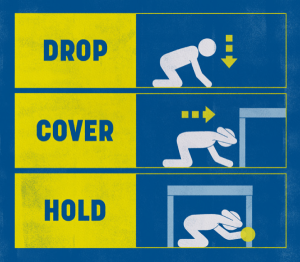 Drop, Cover and Hold is the right action to take during an earthquake. It stops you being knocked over, makes you a smaller target for falling and flying objects, and protects your head, neck and vital organs.
Drop, Cover and Hold is the right action to take during an earthquake. It stops you being knocked over, makes you a smaller target for falling and flying objects, and protects your head, neck and vital organs.
If you feel an earthquake:
- DROP down on your hands and knees. This protects you from falling over but lets you move if you need to.
- COVER your head and your neck (or your entire body if possible) under a sturdy table or desk (if it is within a few steps of you). If there is no shelter nearby, cover your head and neck with your arms and hands.
- HOLD on to your shelter (or your position to protect your head and neck) until the shaking stops. If the shaking shifts your shelter around, move with it.
During an earthquake, the biggest hazard is earthquake shaking, as it can lead to collapsing walls and roofs, and falling glass and objects. Many injuries are caused by people moving during or immediately after the shaking.
In a major earthquake, masonry and glass falls off buildings and into the streets. If you are inside, Drop, Cover and Hold – do not run outside or you risk getting hit by falling bricks or concrete and glass. You should only leave if the building is showing obvious signs of distress, or if you are in a tsunami evacuation zone. Read more about what to do during a tsunami.
Do not try to stand in a doorway – in modern homes, doorways are no stronger than any other part of the structure and usually have doors that can swing and injure you.
Even after earthquake shaking stops, move with care as debris can cause further injuries.
If you are outside, move away from buildings, trees, streetlights, and power lines, then Drop, Cover and Hold. Stay there until the shaking stops.
If you are in bed when the shaking starts, Stay, Cover, Hold: Stay in bed. Cover yourself by pulling the sheets and blankets over you. Hold your pillow over you to protect your head and neck.
You are less likely to be injured if you stay in bed.

If you are inside a building, Drop, Cover and Hold. Stay indoors until the shaking stops and you are sure it is safe to exit. In most buildings in New Zealand, you are safer if you stay where you are until the shaking stops. Do not run outside after an earthquake.
If your wāhi mahi / workplace is in a tsunami evacuation zone and the earthquake is Long or Strong, move immediately after the shaking stops to the nearest high ground or as far inland as possible out of tsunami evacuation zones.
After the shaking stops, do a head count and work out if anyone’s unaccounted for. Check stairs and bathrooms. If you can, gather in one place.
If you are outside, find a clear area away from buildings, trees, streetlights, power lines, unstable slopes and cliffs: these may fall and cause injuries during an earthquake.
Drop and Cover: Drop down on your hands and knees and cover your head and neck with your arms. Stay where you are until the shaking stops.
In a major earthquake, the ground shaking will make it difficult or impossible for you to move any distance.
If possible Drop, Cover and Hold.
If you cannot safely get under a table, move near an inside wall of the building away from windows and tall items that can fall on you.
If you have difficulty getting onto the ground, or cannot get back up again without the help of a caregiver, then follow these recommendations:
- If you are in a recliner or bed, Stay, Cover, Hold: Stay in bed. Cover yourself by pulling the sheets and blankets over you. Hold your pillow over you to protect your head and neck.

- If you are using a cane, Drop, Cover and Hold or sit on a chair or bed and cover your head and neck with both hands. Keep your cane near you so it can be used when the shaking stops.
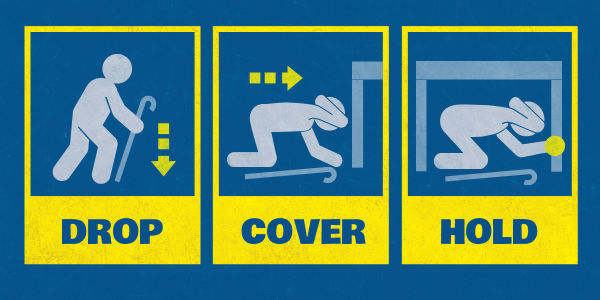
- If you are using a walker, Lock, Cover and Hold. Lock your wheels (if applicable). Carefully get as low as possible, bend over, and Cover your head and neck as best you can. Hold on until shaking stops.
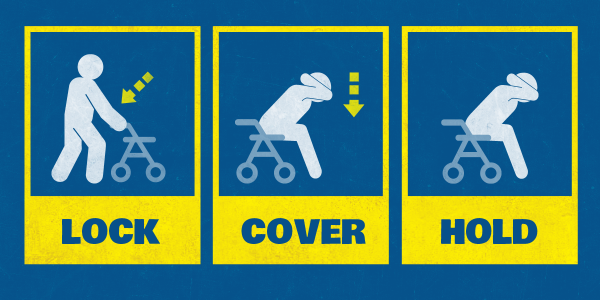
- If you are using a wheelchair, Lock, Cover, Hold. Lock your wheels. Bend over and Cover your head and neck as best you can. Hold on until shaking stops.
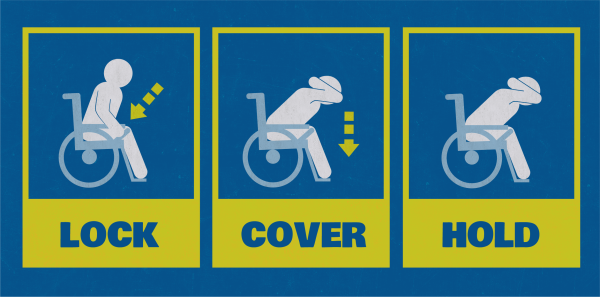
- If you are sitting in a chair, Stay, Cover, Hold. Bend over and Cover your head and neck as best you can. Hold on until shaking stops.
If you are driving, Pull Over and Wait.
- Pull over: to a clear location, away from trees, power lines, poles, street signs, overpasses, cliffs, and other overhead items, that may fall during earthquakes.
- Wait: stop and keep your seatbelt fastened until the shaking stops.
Once the shaking has stopped, proceed with caution. Avoid bridges, tunnels, cliff roads, ramps – any features that might have been damaged by the earthquake.
There may be more emergency vehicles on the road than normal. Make sure you allow them past as soon as it is safe to do so.
Listen to your car radio for advice from emergency services and your local Civil Defence Emergency Management Group.
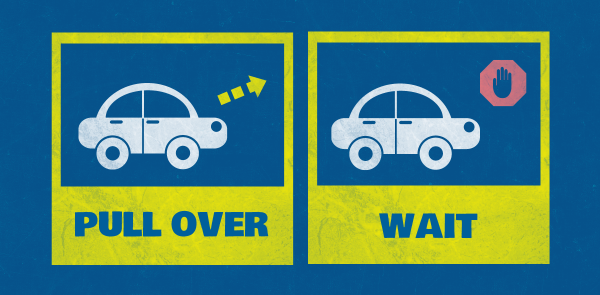
Pick them up and hold them against your chest as you Drop, Cover and Hold.
If you can’t get under a table or piece of furniture, drop to the ground and protect the child with your body while doing your best to cover your own head and neck.
If you’re breastfeeding, stay seated or in bed, shielding your bodies with blankets or pillows.
Your instinct will be to run to them – don’t. If you run or move during earthquake shaking you could be seriously injured. If you’re injured, you won’t be able to help.
Immediately Drop, Cover and Hold or Stay, Cover and Hold if you are in bed. If possible, call out to the child and tell them to Drop, Cover and Hold or Stay, Cover and Hold if they are in bed. Talk to them in a reassuring voice to alleviate panic and anxiety.
Stay where you are until the shaking stops. Move with care when you go to check on the child as debris can cause injuries.
Earthquakes can generate tsunami.
It is important to recognise the natural warning signs of a tsunami and remember, if an earthquake is Long or Strong: Get Gone.
You may find other information (not Drop, Cover and Hold) on the Internet about what to do in an earthquake. Much of it has been discredited and should not be followed.
Research from the United States, Taiwan, Japan and Christchurch (all places with modern, earthquake resistant building design codes), supports and recommends the core message for New Zealand: Drop, Cover and Hold is the right action to take in an earthquake.
- Check yourself for injuries and get first aid if necessary. Help others if you can.
- If you are in a tsunami evacuation zone you need to move to higher ground immediately, or as far inland as you can, out of tsunami evacuation zones. You can read more about what to do during a tsunami here.
- Look quickly for damage around you, particularly in buildings where furniture and fittings may have become hazardous.
- Look for small fires and, if safe to do so, extinguish them.
- If you can, put on protective, weather appropriate clothing that covers your arms and legs and sturdy footwear in case you have to move through debris.
- If you are in a store, unfamiliar commercial building, or on public transport, follow the instructions of those in charge.
- If you are at mahi/work, gather information about your building (e.g. are the stairs to the ground level useable) and what is happening around your area and elsewhere in town. If practical, keep a register of who’s present, log when people leave and note what they plan to do next (e.g. fetch children from day-care, walk home etc.). Arrange to travel in groups.
- Do not run outside unless the building is showing obvious signs of distress, or you are in a tsunami evacuation zone. It is frightening to stay in a building, but it is much safer than immediately going outside, where masonry and glass could fall on you.
- Your usual fire evacuation assembly area might not be a safe location after an earthquake if it is exposed to falling glass and masonry.
- When you eventually leave, take your wallet, keys, and phone. You are more vulnerable if you leave those things behind. If you have a grab bag, take it with you.
- Avoid travelling through tsunami evacuation zones to return home.
